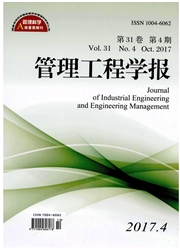

 中文摘要:
中文摘要:
针对产供销一体化企业中的选址-路径-库存系统联合优化问题,引入碳配额差值系数,构建了考虑碳配额差值和选址-路径-库存经济成本多目标模型,并使用改进的多目标混合粒子群算法(MOHPSO)对问题进行求解。对模型求解得到的帕累托最优解集可以根据决策者的环保偏好选择最佳的运作方案。基于中石油东北化工销售公司真实实例的计算实验表明所构建的模型和算法是有效并可行的,灵敏度分析验证了所给出的帕累托前沿具有较好的均匀性。
 英文摘要:
英文摘要:
With the degradation of environment in last few years, the issue of low-carbon supply chain management has raised more interest both in the academia and industry. Some studies have shown that economic cost and the level of carbon emissions are either strong or weak. However, no study has explicitly considered the trade-off between economic cost and carbon capped-difference (CCD) for the locatinn-routing-invantory problem (CLRIP). Besides, the trade-off between carbon emissions and costs are usually modeled as a single objective optimization problem. Because the problem involves different incompatible objectives, a multi-objective model is more appropriate and realistic. In this paper, we introduce a supply chain network design which incorporates CCD into the CLRIP model and makes a trade-off between economic cost and environmental impacts. The distinct feature of this model is that environmental and cost are considered together. Specifically, CCD with government behavior is incorporated into location, routing and inventory joint optimization problems. Firstly, the concept of CCD is introduced. Sequentially, the economic cost and CCD function are acquired. A multi-objective mixed integer programming model is formulated for CLRIP in consideration of CCD. After that, an improved multiple optimization hybrid particle swarm optimization (MOHPSO) heuristic procedure is used to solve the model. In order to obtain the global optimal solution, the heuristic procedure allows some infeasibility solutions closed to Pareto frontier in solution space in the initial evolution phase. The infeasibility solutions are reduced gradually in the later evolution stage. This improved MOHPSO heuristic procedure can handle both continuous and binary variables. A set of non-dominated solutions is attained in the end. Finally, the proposed model is implemented based on an authentic case from the northeast chemical sales company PetroChina. The Pareto optimal curve of the multi-objective model provides a portfolio of configurati
 同期刊论文项目
同期刊论文项目
 同项目期刊论文
同项目期刊论文
 期刊信息
期刊信息
